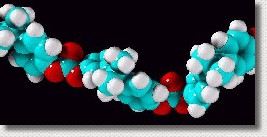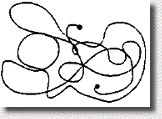|
and Elastomers  The word 'polymer' means 'many parts'. A polymer molecule is a long chain of covalent-bonded atoms, such as the one shown on the right. Most polymers are carbon based, with a large molecular weight, and have relatively low melting points. Natural rubber, for example, is a polymer, and has a molecular weight of about 350,000. Two important polymeric materials are plastics and elastomers (rubbers). There are many types of each.
Electron microscope image of the polymer molecules in a styrofoam packaging 'peanut'. In both types of polymers, secondary bonds hold groups of these polymer chain molecules together to form a polymeric material, much like a handful of cooked spaghetti noodles. If the molecules are well-attached to each other, you get a plastic. But if the molecules aren't stuck to each other too much, the material can be stretched, and is called an elastomer. Elmer's Glue is a liquid polymer, where the molecule strands are not joined at all ... they can slide past each other, and the liquid can 'flow'. When the borax is added, it forms chemical bonds between the strands, linking them together, and stopping the material from flowing. It is now a rubbery solid. But the molecules aren't fixed in place, like a hard plastic, so they can still be stretched. The putty is a form of elastomer, even though it doesn't snap back to its original shape after you stretch it.
|

